Olivier Levasseur is an authentic pirate nicknamed "The Buzzard" because of the way he attacks his victims.
Who more authentic than the pirate La Buse?!
His treasure comprises his classic authentic pirate's image, a booty of pearls, diamonds, gold and silver dishes, encrypted messages,
caves, a mysterious island, and maps where hideouts abound!
La Buse the famous pirate skimmed the Indian Ocean at the beginning of the 18th century. He supposedly hid a treasure estimated at
4.5 billion Euros somewhere in the Réunion Island. Still today researchers and scientists are looking for this treasure preciously
conserved for over 280 years.
Olivier Levasseur was born in Calais at the end of the 17th century. In 1721 La Buse was associated with the English pirate Taylor.
During the month of April they captured Portuguese vessel La Vierge du Cap (The Virgin of the Cape), that
had sought shelter from a storm in Saint-Denis harbour (Bourbon Island) with 72 canons.
On board the vessel were the count Ericeira, the vice king of India and Goa's archbishop. La Buse demand a ransom for the
vice king, but acquired items of priceless value: rivers of diamonds, jewelry, pearls, gold and silver bars, furniture, fabrics, sacred
vases, chests of gemstones, and the golden stick of GOA dotted with rubies weighing a hundred or so kilos, all estimated at 4.5
billion Euros.
La Vierge du Cap (The Virgin of the Cape), refitted and refurbished, became La Buse's vessel and was named Le Victorieux
(The Victorious).
But a year later, Duguay-Trouin and the English commodore Matthews came into the area to battle against each other. La Buse and Taylor
were suspicious of and didn't trust them, and thus sailed away. Taylor ran away to the Antilles and La Buse went to Sainte-Marie Island
near Madagascar's coast.
He retired because being a pirate wasn't possible anymore with someone like Duguay-Trouin, whose pavilion was gloriously
floating from Ecuador to Cape of Good Hope after him.
Most pirates also ceased their activities and became peaceful citizens enjoying the charter of leniency offered by the king
of France. Their ships festered in their coves and piracy disappeared.
Almost alone La Buse waited before accepting the Charter, gave back the sacred vases, but couldn't bring himself to give back the
Virgin of the Cape's booty, condition of the leniency.
It is certain that he hid the treasure, but where?
Six islands were shortlisted: Mauritius, Réunion Island, Frégate Island, Mahé, Rodrigues, Sainte-Marie.
In any case, it was in Sainte-Marie that Levasseur was living, illegally but in no immediate danger... talking about submission
with no hurry to stop.
Around 1729, being a pilot in the Antongil (Madagascar) bay, he offered his services to The Medusa vessel of the Indies Company
that wanted to come into the harbor.
The Hermitte's Captain, the ship commander, recognized him, and remembering that the pirate had many times boarded ships from his company,
arrested him.
On July 7 1730 La Buse was sentenced to die at 5 pm.
When he stepped on the scaffold to pay for his pirate crimes, Olivier Levasseur, also known as La Buse, threw a cryptogram into the crowd
and yelled:
- "Mes trésors à qui saura comprendre !" (My treasures to those who will understand!)
Thus La Buse hanged, the cryptogram thrown into the crowd, and the hidden treasure offered to the cleverer ones.
Who picked up the secret message?
Nobody could really tell, but for more than two centuries now the Indian Ocean from the Seychelles Islands to the tip
of Madagascar is the center of unrelenting searches and abounds in locked documents, riddles, and engraved signs which all, according
to the legend, relate to La Buse's prodigious treasures.
La Buse's strange cryptogram
The translation of the cryptogram is somewhat confusing, since it makes no apparent sense. See for yourself:
(click on the picture to enlarge it)
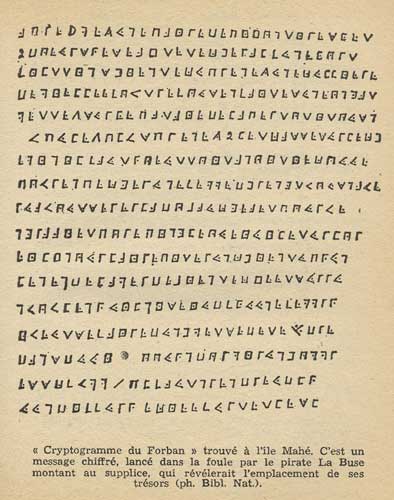 Literally we can read: (in French)
Literally we can read: (in French)
"aprè jmez une paire de pijon tiresket
2 doeurs sqeseaj tête cheral funekort
filttinshientecu prenez une cullière
de mielle ef ovtre fous en faites une ongat
mettez sur ke patai de la pertotitousn
vpulezolvs prenez 2 let cassé sur le che
min il faut qoe ut toit a noitie couue
povr en pecger une femme dhrengt vous n ave
eua vous serer la dobaucfea et pour ve
ngraai et por epingle oueiuileturlor
eiljn our la ire piter un chien tupqun
lenen de la mer de bien tecjeet sur ru
nvovl en quilnise iudf kuue femm rq
i veut se faire dun hmetsedete s/u dre
dans duui ooun dormir un homm r
esscfvmm / pl faut n rendre udlq
u un diffur qecieefurtetlesl
If we try to decipher this text, we will read: (in French)
"Prenez une paire de pijon, virez
les 2 coeurs...tête de cheval... une kort
fil winshient écu prenez une cuillière
de mielle... outre vous en faites une ongat
mettez sur le passage de la...
...Prenez 2 liv cassé sur le chemin
Il faut... toit à moitié couvé
pour empêcher une femme... vous n'avez
qu'à vous serrer la... pour veni
... épingle ...juillet...
.. faire piter un chien turc un
... de la mer... bien sécher et sur
... qu'une femme qui
veut se faire d'un...
dans... dormir un homme
... faut en rendre...
qu'un diffur..."
We can see the Knight Templars' alphabet used by La Buse in the diagram below.
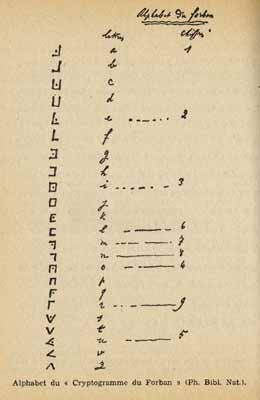
Either the translation is wrong and so we wouldn't understand that words in French would appear, or this cryptogram should be read
at another level. Pirates didn't need any literature to find their treasures again, at most they'd need a few coordinates.
This is what Knight Templars' alphabet should look for and an inhabitant of La Réunion has been very close to find them. Bibique, by the real name
Joseph Guy Germain Tipveau, brought a new clue to this quest for the truth in 1994. He realized that there was a link between the pirate's
scroll and the stone displayed in the hall of la Possession's city hall. This stone was discovered in the Ravine à Malheur (Ravine of Misfortune)
on Crémont's path - renamed the Englishmen's path. Bibique then wrote:
 "
"Something weird stunned me: how come that in La Buse's cryptogram, we only find three pointy "A" when all the others are squared?""
"
"Something weird stunned me: how come that in La Buse's cryptogram, we only find three pointy "A" when all the others are squared?""
He compares and convinces himself that the "A" in the text are the same as on the rock. On the rock, the "A" forms a triangle. And
Bibique as a trigonometry amateur is then convinced that we just need to trace a bissector in the right way to find the location
of the treasure. Except that we first need to find the original location of the stone!
In 1923, on the island of Mahé, south of the Seychelles, Ms. Savy was the owner of land along the sea.
One day she discovered sculpted stones lying in the sea as there are so many in the Indian islands. What was weird is that she could
distinguish animals engraved by human hand: dogs, snakes, turtles, horses, and objects and human forms: an urn, hearts, the face
of a young woman, a man's head and an eye monstrously opened.
An ethnographer suggested: that these rock sculptures could be related to ideographic Indonesian and Easter Island scriptures
where we frequently find snakes and turtles.
But what about the rest? From which civilisation are the human forms, the dogs, the eye, etc.?
Everything is related to La Buse's mysterious treasure, but also to another pirate: Bernardin Nagéon de L'Estang.
Both treasures might even be the same by way of inheritance and robbery!
The strange similarity between La Buse's treasure and Bernardin Nagéon de L'Estang's treasure
The last owner of the Indian Ocean's treasure that look like La Buse's treasure is the pirate Bernardin Nagéon de L'Estang,
also known as Butin (Booty), who was the son of a navy officer of the Indies Company.
In his will, the pirate Bernardin wrote an excerpt from his life. He enrolled and defended his country. He knew that he would probably be killed.
That is why he wrote this will for his nephew Jean Marius Nagéon de l'Estang who was an officer of the reserve which consists
of half a land around the river La Chaux au Grand-Port, Island of France (île de France), and treasures saved from the Indus!
=> Note from the author of the website: I don't cite on this website the whole will which is quite long.
But a lot of information described in this will is strangely similar to the indications given in La Buse's cryptogram!
The similarities are:
- in the locations and the fact that researchers closely link Bernardin and La Buse
- in the riddles
- in the encrypted documents and engravings on the stones, the reminder states the initials S.B.N. or B.N. as well as the letters Ghe
- in the words ring (organeau), turtle, eye
- in the Masonic symbolism.
A lot of coincidence!
It is also possible that in order to deepen the mystery the researchers knowingly forged or falsified the clutter of documents.
Butin has four treasures! Two have been identified, one has been discovered.
The treasures might be at these locations:
- in the island of France (Mauritius) in Belmont in the north of the island in a cave of the river La Chaux near Mahébourg, at the
tip of Vacoas.
- in the Rodrigues island (more doubtful!).
These treasures are locked in caves marked by the initials B.N. engraved in the rock.
And finally, one of the four treasures has been found in 1916 in Pamba Island near Zanzibar. This treasure was Butin Nagéon's as
it was marked with the initials B.N.!
But couldn't the treasure of the Virgin of the Cape pillage by La Buse be in Sainte-Marie Island, where the pirate used to live and
where he could have closely guarded the treasure estimated at 4.5 billion Euros?
Recent information (click on the images to enlarge them)
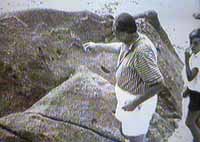 In 1949 Reginald Cruise-Wilkins (1913-1977) contracted malaria and doctors advised him to rest in the Seychelles. That's where
he accidently came into contact with this treasure hunt. At the beginning he thought it was a joke and then it became more and more serious.
So in 1949 he started some major search for the Levasseur treasure on the beach of the little village of Bel-Ombre, north of
the Mahé Island.
In 1949 Reginald Cruise-Wilkins (1913-1977) contracted malaria and doctors advised him to rest in the Seychelles. That's where
he accidently came into contact with this treasure hunt. At the beginning he thought it was a joke and then it became more and more serious.
So in 1949 he started some major search for the Levasseur treasure on the beach of the little village of Bel-Ombre, north of
the Mahé Island.
Most people thought he was crazy, but he didn't care about others' opinions and knew he was right. He kept on going with his work
because he had a strong intuition.
 Wilkins drew his younger son into the adventure, because he suspected that his entire life would not be enough to find the treasure of
La Buse. To present date only a trade gun, a sword blade, some figurines, and a few coins have been recovered... Small consolation compared
with the 30,000 pounds invested in the cause for several decades!
Wilkins drew his younger son into the adventure, because he suspected that his entire life would not be enough to find the treasure of
La Buse. To present date only a trade gun, a sword blade, some figurines, and a few coins have been recovered... Small consolation compared
with the 30,000 pounds invested in the cause for several decades!
After his death in 1977 John Cruise-Wilkins took over the pursuit of his father's unfinished dream.
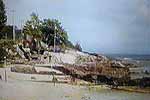 This treasure hunt costs a fortune. Luckily Wilkins works with a rich American partner.
This treasure hunt costs a fortune. Luckily Wilkins works with a rich American partner.
They are convinced that the pirates hid their treasure at low tide. The waves of the rising tide would shelter their treasure.
Opposite: the excavation site of (possibly) the treasure of La Buse. Wilkins blew the rocks up with dynamite to reach the natural entrance
of the cave. Plenty of marks indicate the direction of the location of the treasure of Olivier Levasseur.
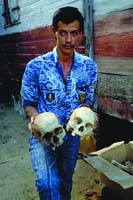 Jacques and Edwards, two other treasure hunters, carried out their research more deeply in the jungle. They discovered old foundations,
an old chest, a bell, lanterns, and bones!
Jacques and Edwards, two other treasure hunters, carried out their research more deeply in the jungle. They discovered old foundations,
an old chest, a bell, lanterns, and bones!
They bickered with Wilkins who pretended that Jacques and Edward created the marks on the boulders...
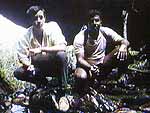 Many other incredible stories continue to spread: one day a family dug up a wine pitcher filled with gold coins in their garden.
Another family discovered irons, cannonballs, and remnants of a camp on a beach. Over the entire archipelago, legends rustle the names
of famous pirates: Hodoul, Boudin, Avery Kid, Halsay, or Taylor...
Many other incredible stories continue to spread: one day a family dug up a wine pitcher filled with gold coins in their garden.
Another family discovered irons, cannonballs, and remnants of a camp on a beach. Over the entire archipelago, legends rustle the names
of famous pirates: Hodoul, Boudin, Avery Kid, Halsay, or Taylor...
In conclusion...
Some written traces indicate that at this time the booty from a ship taken by La Buse was shared between two pirates after their
departure from La Réunion.
Some other skeptics could believe that la Buse would never have buried this treasure on this populated island when there were
numerous deserted islands a few kilometers. But after all, why not?
The story of the famous treasure of La Buse makes its first appearance at the end of the 19th century with Charles de la Roncière,
curator of the National Library, to whom a Dame from Seychelles, Mrs Savy, brings a cryptogram found amongst her family documents. De
la Roncière writes the book "The Mysterious Buccaneer" from this document. The book is published at the beginning of the 20th century.
He brings La Buse to the current light from having been forgotten in the history of La Réunion.
Many adventurer painfully came to dead ends in the quest for this treasure. Bibique (who committed suicide using a 22 Long Rifle
March 31 1995) is a particularly well known case because he spent 30 years scavenging, but there were others. We saw the difficulty of
finding the cabalistic signs that pirates placed on the paths leading to their treasures. Erosion, hurricanes, and urbanization had completely
changed the marks.
To find a treasure nowadays, you should rely more on luck than a scroll. But the dream is alive.
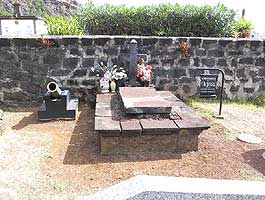
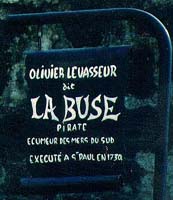
Click to enlarge the grave of La Buse at the St Paul marine cemetery.
It is a symbolic grave. La Buse is not buried there because the cemetery was created in 1788,
58 years after the pirate's death.
On the back of the tombstone are words in tribute to a freed slave woman.
Historically the suicidal or sentenced to death could not be buried in the cemetery. The body of La Buse was exposed for
24 hours on the seashore and simply thrown into the communal grave.
Some links (french):
• In the footsteps of La Buse pirate treasure - A very comprehensive survey by Yannick Benaben

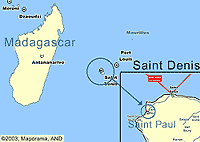


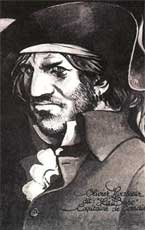


 "
"Something weird stunned me: how come that in La Buse's cryptogram, we only find three pointy "A" when all the others are squared?""
"
"Something weird stunned me: how come that in La Buse's cryptogram, we only find three pointy "A" when all the others are squared?""


 Jacques and Edwards, two other treasure hunters, carried out their research more deeply in the jungle. They discovered old foundations,
an old chest, a bell, lanterns, and bones!
Jacques and Edwards, two other treasure hunters, carried out their research more deeply in the jungle. They discovered old foundations,
an old chest, a bell, lanterns, and bones!
 French version -
French version -